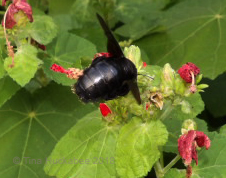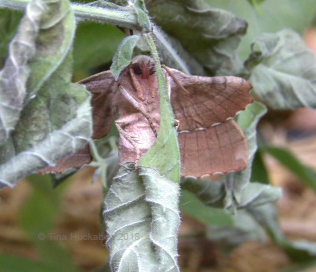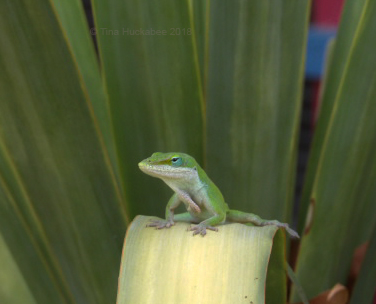Just a quick howdy do! for September’s Wildlife Wednesday, recapping a few flitting winged things from this past month. August is typically hot and quiet, but the garden and its inhabitants remain full of energy and life, even when the gardener drags.
For this whole growing season, I haven’t snagged one good photo of my favorite native bee, the Horsefly-like Carpenter bee, Xylocopa tabaniformis.
There are many of these busily buzzing, nectar-stealing carpenter bees in my garden, but this is the best shot I’ve managed this year. I’m either too slow with the click, or choose a ridiculously windy day to shoot, or am distracted and lose sight of my subject. The bees keep their cool though, working the garden, laying eggs for the next generation, and taunting the gardener with their charm. There’s still plenty of time to work on attaining some decent photos before the days are significantly shortened and these bees bed down for winter. Stay tuned!
I’m continuing to enjoy the Turk’s cap visits of several Southern Carpenter bees, Xylocopa micans.
Like the Horsefly-like carpenter bees, the Southern Carpenter bees nectar-steal and favor Turk’s caps blooms, though I have also seen them at the brilliantly blue, Majestic sage blooms.
These bees are so large, they are easy to spot in the garden, even from a distance.
The big butterflies are now more common, as is typical for the late summer. This Eastern Tiger Swallowtail, Papilio glaucus, nectared at the dramatic flowers on one of my Mexican Orchid trees, which is a favorite of a variety of bees and butterflies.
It took me some time perusing Austin area iNaturalist photos to identify this emerging moth as a Virginia creeper Sphinx, Darapsa myron.
I love his/her little face and tiny chocolate-drop eyes. Some bird-delivered Virginia creeper (the host plant for this moth), growing in my back garden, was probably the food source for the moth in larval stage. This adult emerged in late afternoon from a chrysalis situated on a branch of a Drummond’s ruellia.
The dragons and damsels zoom throughout my garden, but perch near the pond. I think this is a female Dusky Dancer, Argia translata.
The damsel was in nearly constant motion and I took the photo at a distance, so for identification purposes, the photo is not as clear as I’d like. The Dusky Dancer is a common predator and widespread in Texas. The purple eyes are a marked feature for this particular species, so I’m reasonably confident I got this right.
This Pipevine Swallowtail, Battus philenor, has certainly seen better days.
I’m now growing pipevine plant and am enjoying more of these beauties as they float through the garden.
Early one morning I caught this fella nectaring on the salmon blooms of one of my Red Yucca plants.
This Leptoglossus phyllopus is one of the many leaf-footed bugs common in this region and they do fly.
No wings here, but the look on Mr. Green Anole suggests he’s weary of summer and ready for autumn. Or, maybe I’m just anthropomorphizing.
Yeah, that’s it.
I love these little guys and gals and they’ll be around until our chill arrives, which is months away.
What’s in your garden as we wrap up summer? Please share your critter happenings and don’t forget to leave a link to your post. Happy wildlife gardening!











I know you had to be very patient to get those shots. I have had a Pipevine on my Dutchman’s Pipe, but no caterpillars.
LikeLike
Yes, patience is a requirement, but it’s a quality I seem to be a bit short of recently. 🙂 Give it time, I imagine you’ll have some caterpillars and they’ll eat the Dutchman’s to the ground! No worries, though–it pops right back up.
LikeLiked by 1 person
In the past, they have eaten the entire vine and kept it under control. I had to cut it back this year. I need nature’s helpers.
LikeLiked by 1 person
Tina the photos are magnificent. All the animals that come out love me, they are divine. But the Southern Carpenter bee with its black color is a beauty. The photos of the emerging moth of Virginia Sphinx Creeper are fantastic and beautiful. Mr. Green Anole is my garden favorite. Happy Wednesday Wildlife! In my garden there are many different birds, butterflies, grasshoppers, spiders of different types, caterpillars, beetles from small to large with a large antlers, wasps, bees, flies, mosquitoes, lizards and more insects that I do not know how to call. Tina thank you very much for your blogs, I learn a lot with them. Have a nice week. Greetings from Margarita.
LikeLike
Thank you, Margarita! I love the Green anole too–they’re so cute! I’m glad you like my blog and gracias for reading. You have a nice week, too!
LikeLike
Great photos! We have lots of those Carpenter bees in our garden too. They almost look too heavy to fly. Thanks for sharing.
LikeLike
Haha! I hadn’t thought of them that way, but you’re right–those dainty wings carry a hefty bee!
LikeLike
You have some fascinating visitors in your garden! I’m especially envious about the anole: We don’t have them here, and I love those little buddies! I’m always thrilled to see them when I travel south.
LikeLike
I know you love the anoles, Beth. Well, who wouldn’t, they’re such cuties. I wish I could send some to you, but I don’t think they’d like your winters!
LikeLike
I’m late with a WW post, Tina, but hope it’s OK to join in a week past. I’m so sorry to hear about Asher–he truly had a special place in your family. https://plantpostings.blogspot.com/2018/09/ill-be-missing-you.html
LikeLiked by 1 person
Oooh, my favorite Tiger Swallowtail and I have seen so few this year. I always think I don’t have much for Wildlife Wednesday until I go through my photos. I have some standing meetings on Tuesdays and Wednesdays which means its often a challenge to finish up a wildlife post.
Here’s my contribution for the last month.
https://rockoakdeer.blogspot.com/2018/09/wildlife-wednesday-september-2018.html
LikeLike
The Tiger Swallowtails really are just gorgeous. I’ve had a few this summer, along with some of the other big ones, though I’d say there haven’t been quite as many butterflies overall. Not worries on the postings, we do them when we can!
LikeLike
I saw my first baby anole this week. I often see the babies of the black/brown lizards here, but the sight of a two-inch long green anole was a real treat. Between the heat and the rain, it’s been nearly a month since I’ve been out and about to see what was happening on the prairies and refuges. Now, they say there’s more rain for this weekend — I’m so ready for some nice, cool-ish (80s!), dry weather.
I do think I have a photo of a Southern Carpenter bee on a ladies’ tresses orchid. How such a big insect can cling to such a small flower is a bit of an amazement, but when I read that they’re nectar robbers who sometimes just grab on an dbite through the flower — it makes sense of it.
Isn’t it amazing how the butterflies can keep going, even with substantial wing damage? I’ve seen some that have lost nearly half their wing, but they keep on fluttering.
LikeLike
Aren’t the baby anoles adorable? All those anole parts in a teeny-tiny package. 80’s sound wonderful! I know we’re supposed to get rain, and it’s not *quite* as hot as it was. I’ll take it!
Those Carpenter bees are nectar stealers, but I do see them at the blooms, covered in pollen. I guess their bulky bodies aren’t too terribly heavy. And it is amazing when butterflies have a chunk of wing gone and it doesn’t seem to hamper their flight, though I have seen some where the entire wing is so damage that they can’t get much height. It’s a sad sight.
LikeLiked by 1 person
Gads! I was not expecting that dinosaur! What is that leave that he is on. I do not mean to change the subject, but it happens to look like a yucca.
LikeLike
It is a yucca–Yucca recurvifolia.
LikeLiked by 1 person
Oh, Yucca recurvifolia. That is perhaps the third most common yucca here.
LikeLike
It’s fascinating that the Swallowtails here are so very similar to
LikeLike
I agree. I’m always surprised when I see somthing like a Red Admiral photo on a European blog post, too. There are critter threads which connect us all.
LikeLiked by 1 person
Oops! So similar here and there!!!
LikeLiked by 1 person
Many more anole sightings over here lately. And a few solitary butterflies. Plus a rash of cicadas about two weeks ago that seem to have passed along.
Now to enjoy the dragonflies swarming in the evenings still and ignore the ever-growing ant populations…
LikeLike
I haven’t seen many cicadas this year; last summer there were scads of them. Butterflies are always more common (at least around my garden) in the last part of summer and into autumn.
LikeLike
Your lizard is very cool. And I am jealous of the pipevine swallowtail. I’ve got a Dutchman’s Pipe vine, but haven’t seen any PV swallowtails to date.
LikeLike
Nice little friends you have there.
LikeLike
Haha–they are fun!
LikeLike